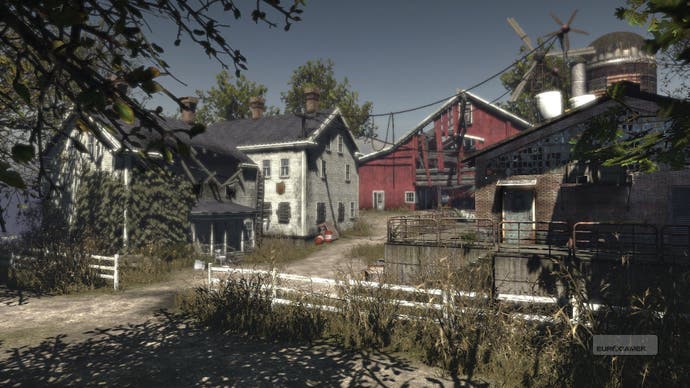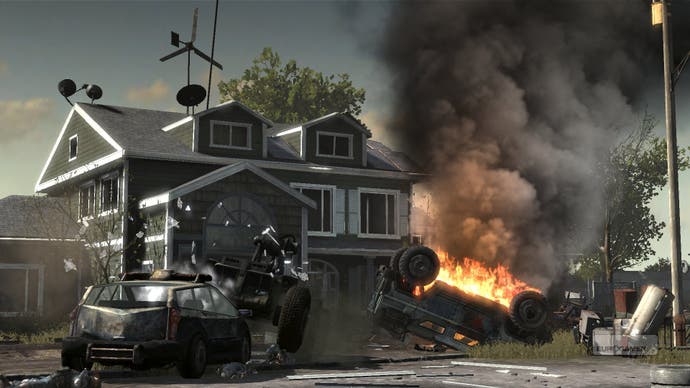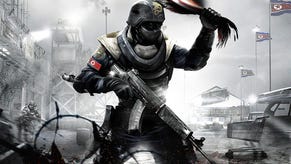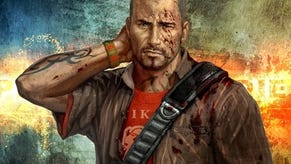E3: Homefront
Defending the US from occupation.
We haven't swung the high-concept bat around here for a while, so how about this: Half-Life 2 meets Ghost Recon Advanced Warfighter. Valve's love of first-person storytelling, high-end graphics and mysterious military occupation, and Ubisoft's love of near-future weaponry, remote-control UAVs and current-day politics stretched to a fictional extreme. Kaos Studios' Homefront will have to go an enormous way to live up to that billing - and the developers aren't so immodest as to refer to either chart-topper when I visit - but the parallels are all there on the surface.
Set 20 years in the future, Homefront dumps you in Montrose, Colorado in a ramshackle, makeshift village of refugees fleeing an improbable North Korean occupation of the US. With a 10-year-long energy crisis in full effect, the Korean People's Army, thanks to mysterious and untold backing, has crushed its neighbour to the south and struck out for new territory, leaving you to pick through the rubble and feed off the droplets of water and electricity accumulated by windmills, aquifers, turbines and solar panels. Your identity isn't clear yet (although you're referred to as Connor Mason - "but he's on the list!"), and you're not helped to any conclusions by your lack of spoken dialogue in the first-person, in-game cut-scenes that establish the demonstration level's setting.
But you are quickly impressed by Kaos' application of Unreal Engine 3. Waking up in a suburban family house pocked with holes and tears, you catch a glimpse of windmills outside through the ceiling rafters as you sit up and take in a room full of plants - in pots, buckets and even shopping trolleys. "Good, I thought we lost you," says a khaki-clad man in the middle of the room, whose gaze and head movements follow you around. "They're going to be coming for us. We need to get everyone moving." You follow him outside, where people are packing up to do just that. A woman walks past with a baby in her arms. "Honestly, if we just landed in one place for more than a few weeks, then we could make a life out here," says your new friend.

And then, as promised, they do come for you, and equipped with an adaptive carbine rifle (ACR), you rush outside to meet them. The transition from walk-and-talk to run-and-gun is abrupt, but coherent, and the atmosphere around the previously peaceful streets is suddenly as oppressive as anything in Call of Duty 4. You duck behind cover and pop up to fire with tight iron sights, reminiscent of Killzone 2, as KPA troops leap out of Jeeps and respond. You stop and throw a grenade at a machinegunner in the rafters of a nearby building, and drones fly overhead. Turning your attention back to the battle, an RPG hits a cover point just in front of you and the sound gets muffled, the graphics saturated. When it wears off, your character reaches for his ACR again and resumes.
Your objective is simple: get across the street and activate something called "Goliath". Achieving it is rather less simple, because the KPA have you pinned down. Fortunately, you get your own RPG and fire it at an incoming truck, which bounces towards you in flames, forcing you to dodge right into the safety of the target house. Here you find the controls for Goliath. "Goliath's in the back garden, it'll rip through the house!" Sure enough. Goliath, it turns out, is a remote-controlled war buggy reminiscent of the Tumbler Batmobile, and attacks things that you identify with a laser designator, rumbling over car wrecks and anything else in the way. By the time the level finishes a minute or so later, it's done a lot of damage.

Pretty, confident and action-packed, the Homefront demo nevertheless makes a rather generic first impression. But speaking to lead designer Erin Daly fills in a lot of the blanks, and puts other elements in a different context. That bit where you shoot the truck with an RPG, for instance, and it bounces towards you, is part of what Kaos refers to as the "drama engine". "The way that works is, basically, wherever you are in that scenario, you blow up that Jeep and that wreckage is going to track towards the player," says Daly. "You're not always going to be in the same spot, so if you're 10 metres to the left and you blow that thing up you're still going to have to dodge it within a couple of seconds." Another example is incoming enemy attacks: your squad-mate might get an order from the drama engine to spin around and brutally kill someone who's running towards you so he's cut down before you can react, but in enough time to see it unfold.
What's more, there's a definite logic behind these scripted events. One example in the current demo is the incoming RPG round, and the groggy, Saving Private Ryan aftermath. As THQ's Sean Dunn puts it, "it's not going to do that while you're looking the other way". Nor will each event be obligatory, tying you to a particular location until you hit the right mark to enable the next set-piece. "It's a completely tunable logic system," says Dunn, "so we don't want it to be where the drama engine controls the pace. It's there to enhance the player's visual take on the world and the action."





